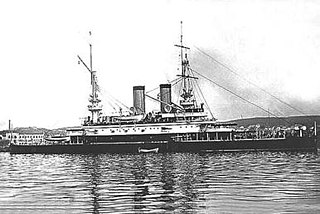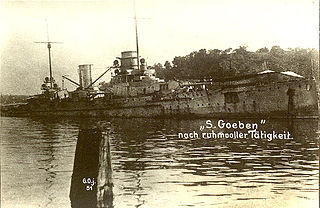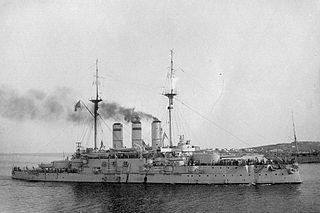
SMS Goeben was the second of two Moltke-class battlecruisers of the Imperial German Navy, launched in 1911 and named after the German Franco-Prussian War veteran General August Karl von Goeben. Along with her sister ship, Goeben was similar to the previous German battlecruiser design, Von der Tann, but larger, with increased armor protection and two more main guns in an additional turret. Goeben and Moltke were significantly larger and better armored than the comparable British Indefatigable class.

The Russian battleship Potemkin was a pre-dreadnought battleship built for the Imperial Russian Navy's Black Sea Fleet. She became famous during the Revolution of 1905, when her crew mutinied against their officers. This event later formed the basis for Sergei Eisenstein's 1925 silent film Battleship Potemkin.

SMS Breslau was a Magdeburg-class cruiser of the Imperial German Navy, built in the early 1910s and named after the Lower Silesian city of Breslau. Following her commissioning, Breslau and the battlecruiser Goeben were assigned to the Mittelmeerdivision in response to the Balkan Wars. After evading British warships in the Mediterranean to reach Constantinople, Breslau and Goeben were transferred to the Ottoman Empire in August 1914, to entice the Ottomans to join the Central Powers in World War I. The two ships, along with several other Ottoman vessels, raided Russian ports in October 1914, prompting a Russian declaration of war. The ships were renamed Midilli and Yavûz Sultân Selîm, respectively, and saw extensive service with the Ottoman fleet, primarily in the Black Sea against the Russian Black Sea Fleet.

The pursuit of Goeben and Breslau was a naval action that occurred in the Mediterranean Sea at the outbreak of the First World War when elements of the British Mediterranean Fleet attempted to intercept the German Mittelmeerdivision consisting of the battlecruiser SMS Goeben and the light cruiser SMS Breslau. The German ships evaded the British fleet and passed through the Dardanelles to reach Constantinople, where they were eventually handed over to the Ottoman Empire. Renamed Yavuz Sultan Selim and Midilli, the former Goeben and Breslau were ordered by their German commander to attack Russian positions, in doing so bringing the Ottoman Empire into the war on the side of the Central Powers.

The Evstafi class were a pair of pre-dreadnought battleships of the Imperial Russian Navy built before World War I for the Black Sea Fleet. They were slightly enlarged versions of the Potemkin, with increased armour and more guns. Numerous alterations were made as a result of experience in the Russo-Japanese War of 1904–5 that seriously delayed the completion of the two ships.

Tri Sviatitelia was a pre-dreadnought battleship built for the Imperial Russian Navy during the 1890s. She served with the Black Sea Fleet and was flagship of the forces pursuing the mutinous battleship Potemkin in June 1905. During World War I the ship encountered the German battlecruiser SMS Goeben twice, but never hit the German ship, nor was she damaged by her. From 1915 onward she was relegated to the coast bombardment role as she was the oldest battleship in the fleet. Tri Sviatitelia was refitting in Sevastopol when the February Revolution of 1917 began and she was never operational afterwards.

Gaulois was one of three Charlemagne-class pre-dreadnought battleships built for the French Navy in the mid-1890s. Completed in 1899, she spent most of her career assigned to the Mediterranean Squadron. The ship accidentally rammed two other French warships early in her career, although neither was seriously damaged, nor was Gaulois.

The Battle of Cape Sarych was a naval engagement fought off the coast of Cape Sarych in the Black Sea during the First World War. In November 1914, two modern Ottoman warships, specifically a light cruiser and a battlecruiser, engaged a Russian fleet including five obsolescent pre-dreadnought battleships in a short action.

The Battle of Imbros was a naval action that took place during the First World War. The battle occurred on 20 January 1918 when an Ottoman squadron engaged a flotilla of the British Royal Navy off the island of Imbros in the Aegean Sea. A lack of heavy Allied warships in the area allowed the Ottoman battlecruiser Yavûz Sultân Selîm and light cruiser Midilli to sortie into the Mediterranean and attack the Royal Navy monitors and destroyers at Imbros before assaulting the naval base at Mudros.

Evstafi was the lead ship of her class of two pre-dreadnought battleship of the Imperial Russian Navy's Black Sea Fleet. She was built before World War I and her completion was greatly delayed by changes made to reflect the lessons of the Russo-Japanese War of 1905.

Ioann Zlatoust was an Evstafi-class pre-dreadnought battleship of the Imperial Russian Navy's Black Sea Fleet. She was built before World War I and her completion was greatly delayed by changes made to reflect the lessons of the Russo-Japanese War of 1905. She was the second ship of her class.

Berk-i Satvet was a torpedo cruiser of the Ottoman Navy, the second and final member of the Peyk-i Şevket class. She was built by the Germaniawerft shipyard in Germany in 1906–1907, and was delivered to the Ottoman Navy in November 1907. The ship's primary armament consisted of three 450 mm (17.7 in) torpedo tubes and a pair of 105 mm (4.1 in) guns, and she was capable of a top speed of 21 knots. The ship's early career was uneventful; the Italo-Turkish War of 1911–1912 passed without any action of the Ottoman fleet. Berk-i Satvet saw action during the Balkan Wars of 1912–1913 in the Aegean and Black Seas, against Greek and Bulgarian opponents, respectively.

On 8 January 1916 the Russian dreadnought Imperatritsa Ekaterina Velikaya and the Ottoman battlecruiser Yavuz Sultan Selim encountered one another in the Black Sea. After a brief exchange of fire the Ottomans withdrew.

Yadigar-i Millet, originally built as SMS S166, was one of the four S138-class torpedo boats built for the German Imperial Navy, but was purchased by the Ottoman Navy National Support Association for the Ottoman Navy.
Nümune-i Hamiyet, originally built as SMS S167, was one of the four S138-class torpedo boats built for the German Imperial Navy, but was purchased for the Ottoman Navy during construction.
Gayret-i Vataniye originally built as SMS S168, was one of the four S138-class torpedo boats built for the German Imperial Navy, but was purchased for the Ottoman Navy during construction.
Samsun was one of the four Durandal-class destroyers purchased by the Ottoman Empire from France in 1907. The ship served in the Ottoman Navy during the Italo-Turkish War, the Balkan Wars and World War I.

The Battle of the Bosporus was a naval engagement during World War I on 10 May [O.S. 27 April] 1915 between the Russian Black Sea Fleet and the German battlecruiser Goeben in the Black Sea, north of the Bosporus, resulting in a tactical victory for the Russians. The battle took place during the main operation of the Black Sea Fleet aimed at shelling the Bosporus fortifications. The action of the Goeben led to the interruption of the operation, but it did not manage to inflict significant damage to the Russian fleet, suffering only minor damage itself.













